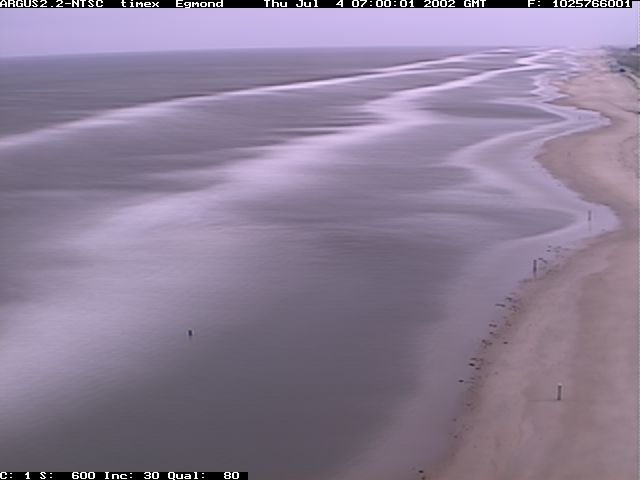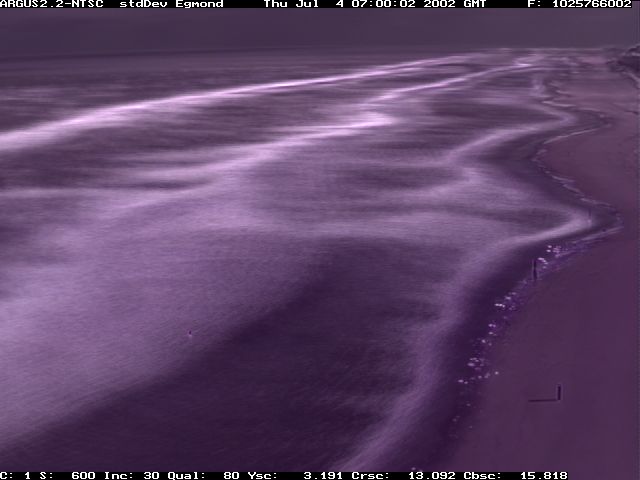Difference between revisions of "Argus image types and conventions"
| Line 1: | Line 1: | ||
Three types of images are gathered from the Argus cameras. Every hour, a snapshot, a time exposure and a variance image are collected for each of the stations cameras. A snapshot serves as simple documentation of conditions, but offers little quantitative information. The time exposure images provide us with much more information. The ten minute time exposures of the nearshore wave field average out natural modulations in wave breaking to reveal a smooth band of white which has been shown to be an excellent proxy for the underlying, submerged sand bar topography (Lippman and Holman, 1989 and Van Enckevort and Ruessink, 2001, [[Argus literature]]). The third type, the variance image, displays the variance of the light intensity signal during the same ten minutes of time exposure. Variance images help identify regions which are changing in time, from those, which may be bright in the time exposure, but are unchanging in time. | Three types of images are gathered from the Argus cameras. Every hour, a snapshot, a time exposure and a variance image are collected for each of the stations cameras. A snapshot serves as simple documentation of conditions, but offers little quantitative information. The time exposure images provide us with much more information. The ten minute time exposures of the nearshore wave field average out natural modulations in wave breaking to reveal a smooth band of white which has been shown to be an excellent proxy for the underlying, submerged sand bar topography (Lippman and Holman, 1989 and Van Enckevort and Ruessink, 2001, [[Argus literature]]). The third type, the variance image, displays the variance of the light intensity signal during the same ten minutes of time exposure. Variance images help identify regions which are changing in time, from those, which may be bright in the time exposure, but are unchanging in time. | ||
| − | [[Image:egmondSnap.jpg | + | [[Image:egmondSnap.jpg|thumb|250px|left|A snapshot image at Egmond aan Zee]] |
[[Image:EgmondTimex.jpg]] | [[Image:EgmondTimex.jpg]] | ||
[[Image:egmondVar.jpg]] | [[Image:egmondVar.jpg]] | ||
Revision as of 15:06, 4 April 2007
Three types of images are gathered from the Argus cameras. Every hour, a snapshot, a time exposure and a variance image are collected for each of the stations cameras. A snapshot serves as simple documentation of conditions, but offers little quantitative information. The time exposure images provide us with much more information. The ten minute time exposures of the nearshore wave field average out natural modulations in wave breaking to reveal a smooth band of white which has been shown to be an excellent proxy for the underlying, submerged sand bar topography (Lippman and Holman, 1989 and Van Enckevort and Ruessink, 2001, Argus literature). The third type, the variance image, displays the variance of the light intensity signal during the same ten minutes of time exposure. Variance images help identify regions which are changing in time, from those, which may be bright in the time exposure, but are unchanging in time.



